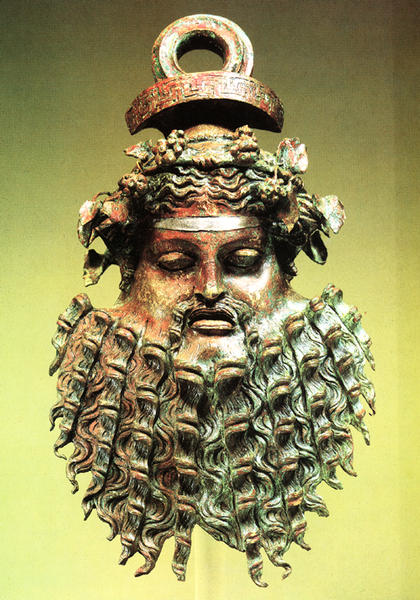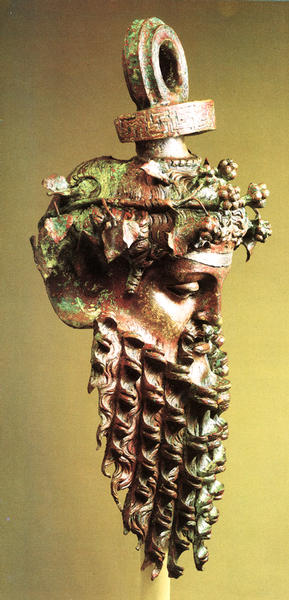シレノス面形把手
- 1世紀前半
- 1c
- ブロンズ、銀、銅
- H-30.5
- 所蔵
- メトロポリタン美術館蔵
解説(開館1周年記念展)
ヘレニズムの時代には図像上で多くの革新が興ったが,踏襲されていったものもあった。この面形は,古典期やアルカイック期にまで遡る様式を,復活とまではいかないが,継承している傾向が見られる。この傾向は2世紀から活況を呈しはじめ,ギリシア人の芸術家はこの趣味を征服者のローマ人にもたらす者として重んじられたのである。
ここに見られる類の面形把手は対でシトゥラと呼ばれるバケット形の容器の両側に付けられ,その上の輪に運搬用の把手を通して使われた。この顔は,ディオニュソスもしくはシレノスを表した可能性が考えられるが,主にその耳が馬のそれであることから後者を表したものであろう。
この種の作品は様々な変種が見られるが,紀元前3世紀の芸術家が制作したとされるエジプト,おそらくアレクサンドリアにあって今は失われた一つの範型から発想したものだったことが想像される。模造を繰り返すことによって変種が産まれることとなったのである。この作品には非常に精緻なひげ,頭髪そして冠の表現が見られ,冠は蔦葉と実で構成され,長い茎で環に取り付けられている。この「複雑なもの」を装飾として造りだすことはアルカイック期のグリフィン嗜好に遡り,色彩や写実性をねらった象嵌の使用も同様であるが,銀象嵌の施されたメアンダー文と鉢巻き,銅象嵌跡を残す唇に見られるように,この作品は古典末期に到達した見事な装飾を伝えている。
Catalogue Entry
For all the change and innovation in Hellenistic iconography, there was also continuity. These three masks demonstrate the tendency to perpetuate, if not to revive, styles going back to the Classic and to even the Archaic period, a tendency that gained impetus from the 2nd century on as Greek artists were being called upon to cater to the tastes of their Roman conquerors.
The mask belong to a group of eight known examples. They were originally used in pairs on opposite sides of bucket-shaped vessels called stulae to accommodate the carrying handle, its ends would have passed through the rings that are preserved on this piece. The subject can be interpreted as either Dionysos or a Silenos, depending on whether one considers the ear predominantly human or equine; the latter form seems more pronounced.
The existence of numerous versions suggests that the source of inspiration lay in a model now lost, that has been attributed to an artist of the 3rd century B.C. in Egypt, possibly Alexandria. The process of reduplication allowed variation, as our examples illustrate. In the other example, the horizontal element below the ring is decorated with running spirals, while this has a swastika meander. This mask also shows the finest execution of the beard, hair, and wreath, which is made of ivy leaves and berries attached by long stems to a circle. The production of a decorative adjunct in "multiples" can be traced back to the Archaic period with its predilection for griffins; so also can the use of inlays for effects of color and realism.
This mask, however, conveys something brilliant decoration achieved during the late period; both the meander ornament and the fillet have silver inlays, while the lips preserve some traces of copper.

